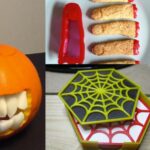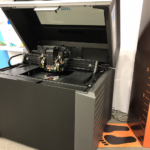

Each year over 140 million bags of coffee are produced worldwide. There are literally dozens of different varieties of coffee that come from many different countries and regions from around the world. Most of this coffee is brewed in traditional fashion, using machines to assist or sometimes even by hand. However, one man named Elias Bakken has decided to defy convention with his 3D printing coffee machine called the Debrew.
You are probably thinking to yourself, “How could a 3D printer make coffee?” Well, “3D printer” is really the closest term that we could come up with for this delta-style machine that runs on g-code. It is much more than a 3D printer in the traditional sense, and it is able to make the perfect cup of coffee every single time.
Specifically the Debrew, as Bakken calls it, is a delta-bot that makes hand brew dipper coffee. The machine, which has had many of its components 3D printed itself, could be considered a coffee making 3D printer. The water flow rate, the grind coarseness and the positions of the tube above the filter, as controlled by stepper motors, and the machine looks eerily similar to any delta-style 3D printer that you will come across.
Making hand brew coffee is no easy task. Just ask anyone who has done it in the past. So Debrew’s pre-soak and extraction process can be visualized and modified using an online web interface that Bakken has created. It features simple drag-drop functionality, and has a basic user interface that allows for the selection of pre-defined coffee profiles. These profiles can be created and edited from this very web interface.
“Making good coffee relies on good craftmanship,” Bakken tells 3DPrint.com. “The skills and equipment required to make that cup of Joe smooth like a good steak, instead of bitter and stale, is something that not a lot of people possess. However, if you do not have the skills, get better equipment. In this case, by handing the task over to someone who does exactly what you want it to every time, namely a robot (Debrew)!”
Debrew’s web interface was created by Bakken from the ground up in order to create a simple user experience, while not requiring them to know how to write g-code. The interface uses many discrete operations and commands, such as “Wait 2 seconds,” “select water,” “draw a 10mm radius circle,” “set coffee bean coarseness,” “set water temperature,” and more. All of these operations can be organized so that when you press “play” they will be automatically converted into g-code and then sent off to the Debrew machine.

Like 3D printing, the Debrew allows for open sourcing of designs — or in this case coffee recipes.
“The great thing about having a high level representation of the coffee making process is that the recipes can be shared similar to how STL models are shared today (with 3D printing),” Bakken tells us. “That way, similar but differently implemented coffee bots can still interpret the recipes.”
One of the issues that Bakken discovered was that he simply didn’t want to be required to open up a web interface on his browser every single time he wanted a cup of coffee. This is where he came up with a product currently being offered on Kickstarter, called the Manga Screen.
This multi-touch 4.3″ LCD screen makes for the perfect counterpart to the Debrew coffee “printer.” It is mounted on the front of Debrew, allowing users to select a coffee recipe and then simply press “play,” without having to any edit any functionality.
“This project was created purely out of love for coffee and robots, and there are no plans for volume production in the near future,” explained Bakken. “However, the two main components, Replicape and Manga Screen are a part of this prototype, so showcasing those is a big bonus. And it would definitely be in my interest if someone was to refine this and make a business out of it. In fact, all the parts in Debrew are open source (even the electronics and software), so the step to a viable product would not have to be that great. It may seem like overkill to go through all this work just for a cup of coffee, but once you’ve tasted that perfect cup, you’ll understand!”
As for Bakken, he is keen on creating unique projects like this. He is a hardware developer with a master’s degree in micro electronics, currently working toward his PhD. He works as CTO of Intelligent Agent.
What do you think about Debrew? Is this the future of coffee making; a 3D printer capable of working off of generated g-code in order to brew the perfect cup of coffee no matter what the recipe is? Discuss in the Debrew forum thread on 3DPB.com.
If you're looking to get architectural 3D animation in the USA, our service provides an exceptional way to bring your architectural concepts to life through dynamic, immersive visuals. Through our platform, you can easily request high-quality 3D animations that showcase your designs in motion, offering a detailed view of your project from multiple angles and perspectives. Whether it's for a real estate development, a commercial building, or an urban planning project, our expert team ensures that every detail is captured in a visually compelling animation.
Through our website, you can seamlessly get architectural 3D animation tailored to your project’s specific needs. With our help, you can offer potential clients or investors an engaging experience that goes beyond static images. By integrating CGI animations with real-world settings, lighting, and textures, our team creates a lifelike experience that allows your audience to interact with your project as though it were already built. This service is perfect for presenting complex designs in a clear, visually attractive way that stands out in the competitive architectural market.




